This page is an automated translation of /nl/atlanticcrossing1.html and is awaiting a manual review.
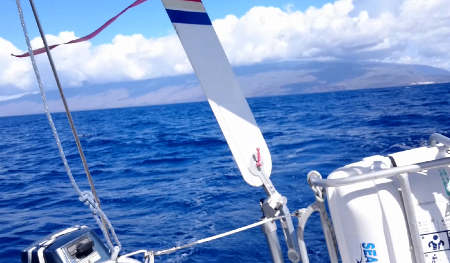
During our stay at El Hierro, the impending departure from Europe is regularly discussed in the small sailing community. Because those who sail to the southernmost Canary island El Hierro usually do not return to the more northern islands, but have Africa or the Caribbean as their next destination. In the port of La Restinga, the port opening has a tempting view to the south, here Europe finally stops and an ocean crossing awaits.
Everyone is waiting for a favorable "weather window" but what that exactly means is different for everyone. When we arrived at El Hierro it was actually quite clear; the wind would blow to the north and then departure to the south is not so obvious. Although just when we arrived a Dutch couple was leaving. We were able to meet Mark and Carolien for just five minutes before they were seen off. In that short time we learned that they have an appointment in Mindelo and have already waited far too long. If the wind doesn't cooperate, they will just turn on the engine. Well that is also possible.
Ed and Megan will leave for Gambia on Sunday morning. Our other neighbor prefers to wait on Wednesday because, according to him, the sea has calmed down a bit from that strange south wind.
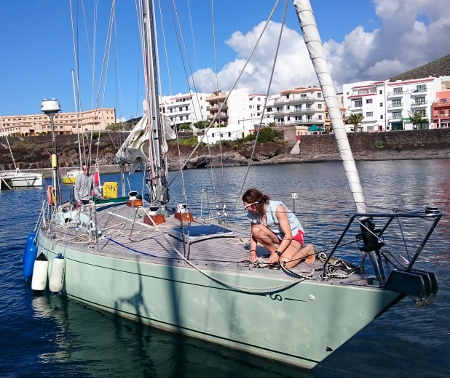
We decide to prepare the boat and on Sunday morning, based on the very latest weather information, make the decision whether or not to leave immediately or to wait a little longer. Our neighbors Ed and Megan are at work, we are at work. We clear the deck and lash what is left firmly. The same scene is happening with them. With them the covers come off the sails, with us a little later too. They will hand in the keys to the port gate and offer to take ours with them as well. We give the keys and unnoticed the decision to leave has actually already been made. The weather information still looks good. At one point Ed is looking to see if he can do anything and asks me: "Are you also running out of jobs?" I confirm the question and am amazed myself that everything is indeed ready. "Well then, have a good journey, huh?" Moments later they cast off the lines. We follow 10 minutes later. While we are leaving the harbor they have already turned against the wind to hoist the sails. When we look back we see another boat following, the "Rock and Roll", a boat with people we had no contact with but who unmistakably also have the destination "south". It is reassuring that there are several people who think this is a good time to start the crossing.
Immediately after the start, everyone sets off in a slightly different direction. The island of El Hierro is an obstacle to the wind and that makes the wind erratic and unpredictable for the first few miles past the island. Ed and Megan apparently have a good fit because they race away. On the AIS I can see that they reach a speed of more than 6 knots, while we are still struggling with flapping sails. We don't find any wind in their direction, so we decide to head more west to get closer to the island. Our strategy eventually works because fifteen minutes later we get more than 20 knots of wind and Omweg is sprinting off at more than 7 knots. But Ed and Megan are already disappearing from view and their AIS is disappearing from our screen. We actually call them a little too late because the connection no longer allows a good dialogue. Well, "wish you all the best and fair winds" and that's it. We also lost the "Rock and Roll" because they lagged a bit behind and did not follow us to the west. They don't have AIS so we don't see them anymore with our equipment. Now we are basically alone on the ocean ...
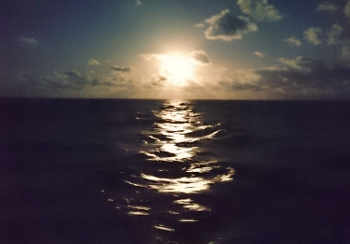
In the night from Saturday to Sunday the clock changed from summer time to winter time. But in Cape Verde they don't do daylight saving time anyway and just always keep UTC-1. This is actually the geographic time zone where El Hierro is located (but they keep a "wrong time" to keep the clock in line with the other Canary Islands) so we decide to set our watches on Cape Verde time, so two hours. difference with the Dutch winter time. Not all our clocks, by the way, because we always keep UTC on all clocks for navigation, communication and photo equipment. That is very easy and gives less confusion.
The first two days we don't have much wind. The first sprint immediately after departure was a local effect due to the proximity of the coast, but that was soon over. It seems nice for laymen not to have so much wind, but it is actually not pleasant at all. The sails catch a breeze, the boat starts to build up some speed, the wind disappears for a moment and clabam, because of the built-up speed we have created our own headwind, an apparent headwind that makes the sails slap backwards. Due to the lack of pressure in the sails, the boat also swings a lot more. As unfortunately every sea sailor knows, it takes one or two days before you feel completely fit and especially with such a messy sea and rocking boat, seasickness is lurking. We go inside as little as possible and keep quiet. For light winds like this we bought a Parasailor, a huge sail that can be put in front of the boat like a parachute. But we have never used that sail before so the first time will be a bit of a hassle. We both do not feel fit enough to get started with this so we keep muddling on with just too little wind. Of course we could use the engine, but strategically that is not a good choice at the start of the crossing. You never know if you will really need the engine later in the trip and then it is a shame if you have already used half of your diesel stock in the first two days. In addition, engines with the drone and diesel fumes is also not conducive to fitness. So we just wait and see. In the meantime, we are secretly making sufficient progress and we do not have to be dissatisfied with our daily average.
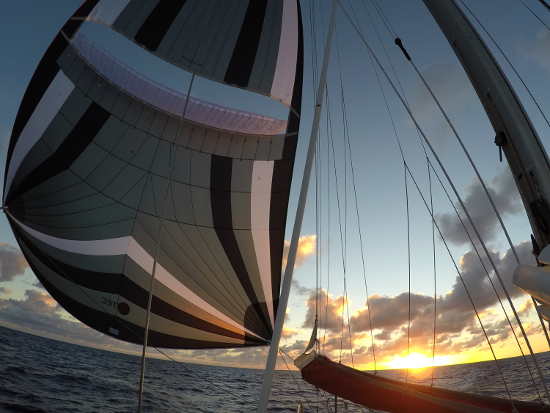
The wind is slowly dropping a little further away, but fortunately we now feel fit enough to try out the Parasailor. It takes a bit of hassle, but after that we have more than 100 square meters of parachute fabric in the air! The clapping has disappeared, the boat is speeding up again and the nervous rocking is also a thing of the past. We download the most recent weather information via the short wave and decide to just leave the Parasailor at night. It will be a wonderful night! Whoever has the "watch" sleeps outside, under a clear starry sky with a view of the Parasailor. The moon is full, so it seems so bright you can almost read. In any case, it gives a nice feeling that you can just see everything around you.
The "keeping watch" means that you are ready to intervene if the situation calls for it. In practice, it means that you regularly (every half hour or so) check whether there is no other traffic coming, whether the course is still in the right direction, and whether there is anything rubbing, rattling or rattling anywhere. In the meantime, take a nap and we soon discover that the person on watch wakes up immediately as soon as the boat makes an unusual noise or movement or the wind suddenly increases. Actually, the same applies to the person who has "sleep" on the schedule, but that is of course not the intention. The person who is allowed to sleep must actually sleep and entrust the boat to the watch, but yes, tell that to your subconscious mind. Nevertheless, the timetable chosen by us appears to work well. At this latitude, there is little change in day length over the seasons; when your clock is set in the right time zone, the sun will always set at 6 pm and rise again at 6 am. We have therefore decided that Ilona will go to bed at 6 pm with sunset, and that I will go to bed at midnight and Ilona will do the honors. This way we both have 6 hours of uninterrupted sleep during the darkness and combined with some hare naps during the watch we both get enough sleep. Those who want to sleep a little extra during the day can of course do so, but in practice it appears that neither of us needs it.
The next day we see in the weather information that the wind will increase the coming night. Reluctantly we take down the Parasailor at the end of the afternoon. That turns out to be not so easy and confirms that we have done well not to wait until it is really necessary because the wind is already blowing too hard. That night the wind will indeed blow so hard that we are happy to have made this decision. It will even blow so hard that it will be a bit exciting. During my watch I see the speed of the boat increasing steadily. We are already over 7 knots. And when we buy 7, we should really reduce the sail. But we are ahead of the wind, the boat does not lean, the controllability is perfectly fine, and for the time being we do not have to maneuver anyway. It is not possible to reduce the sail on this course, so if we want to reef now we have to get off this downwind course so that our apparent wind increases even further, and then tinker with the sail lining in the nightly darkness. I think it would be better to leave it that way and Ilona, who has still not fallen asleep due to the tumult, thinks exactly the same. The predictions are that the wind will decrease again and that appears to be the case later that night. In the meantime, we regularly touch more than 7.5 knots with a maximum of 7.8 knots. Detour flies through the water and it is an exciting but also wonderful feeling. We hear the water hiss around the boat and we leave a colossal trail of foam.
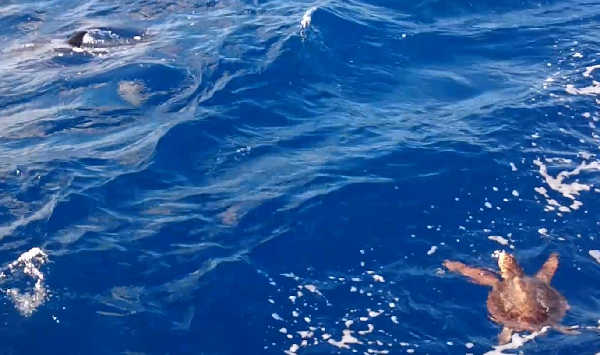
We see more and more flying fish. These are fish that have wing-shaped fins that allow them to actually fly tens of meters. Unfortunately, they cannot steer properly and they seem to regularly end up on the deck of sailing boats. However, the detour is quite high so during the whole week only one flying fish lands on the boat, who is lucky that I see it happen and is thrown back into the water by me in time. A tuna stupid enough to bite into the blue plastic octopus dragged behind the boat meets a different fate, because it ends up in the pan. We have some emotional difficulties with this state of affairs but it is ecologically the best way to feed yourself: no diesel, plastic packaging, etc. is involved. It couldn't be more natural. Apparently that tuna loved to devour cute octopuses and in turn dolphins or other predatory fish would have ended our tuna short. On the water we are dependent on nature and part of nature like we have never been before.
In the meantime, the "free time" bar is disappointing. We expected to have a lot of time to read and stuff. But nothing came of that during this crossing. An important reason is that absolutely everything we do takes many times more time than usual. To give an idea:
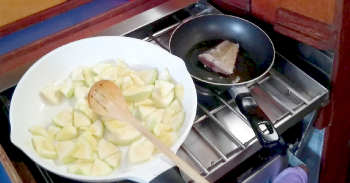
- Food and drink
- The meals remain relatively simple, that goes without saying. The greatest art is not to let it become a big mess. You cannot put anything down or it will lead its own life, usually with the contents detaching from the packaging. The only resting point is the stove: it is a gimbal stove that follows the movements of the boat. But yes, the space on the stove is very limited. We tie the bread (which we also have to bake ourselves) with elastic straps on a grid. Pouring something is impossible: the liquid in the bottle or kettle will also wave, even if you keep it still. Fortunately, we bought thermos flasks with handy taps so that we don't have to pour, but of course you have to get the boiling water into the thermos first. We first tie the thermos to the kitchen wall with straps, but even then it is impossible to get the water in without a substantial part going over the edge. And those were only the preparations; you also have to consume it. In fact, you are short of a hand to hold both yourself and your plate as cutlery. And cups tend to take a kamikaze jump in a fraction of inattention. For example, I destroyed two cups during this crossing. If it continues at this rate then I have to drink from my hands at the end of the next crossing.
- Do the dishes
- In principle, we cannot put anything loose on the counter at sea. This means that each glass, plate or pan must be individually handled completely. So first wash a plate with salt water. Then rinse immediately with drinking water. Dry immediately (because nothing voluntarily remains in the dish drainer) and immediately store well, preferably with paper or foam in between so that it does not rattle. Then the next plate. It would be handy if you could store two plates at the same time, but where do you leave one plate while working on the other? Note: at the end of the week, we found a good solution; the drainer fits exactly on the gimbal stove and that way, washing up is perfect!
- Going to the toilet
- For this you wait for a strategic moment where there are as few waves as possible. In addition to your normal clothing, you may be wearing a sailing suit and life jacket and you have to solve that first. Staying on the toilet is sometimes quite a challenge (urinating while standing is not an option anyway because what is "downstairs" is constantly changing position!) The toilet also works differently than at home because you have to pump the contents out yourself. The trick is to have finished the whole thing before you get seasick. Oh yes and don't forget to put on your sailing suit and/or life jacket afterwards!
- Send/retrieve email
- We do this through the short wave. Switch on shortwave radio. Turn on the modem. Try to guess via a table which stations are reachable at that time. Try to connect. Repeat this a few times if necessary. During this crossing we are reasonably successful in the morning with a station in Switzerland and in the evening with a station in Canada. In the afternoon it is not possible to connect to anything. When we have a connection, we are happy when we reach 500 bytes per minute, sometimes the speed is only 50 bytes per minute ... A small email without attachments often takes several minutes. But of course we are glad that it is possible, that we can still retrieve weather information in the middle of the ocean, and that without incurring any costs. All in all, just retrieving and studying the weather data takes well over an hour every day.
- To sleep
- Nothing seems easier than that. Just lie down and close your eyes, right? But not if you keep rolling from one side to the other while lying down. During a crossing we sleep in the "dog cage", a narrow bed in the back of the boat. In the back because that is where the movement is usually the least. And then you are close to the person who is on the watch. We take a lot of pillows to bed and the intention is to lie as wide as possible so that your bottom touches one wall and your knees the other. To prevent that purse, you push pillows between them. You also try to build in your upper body as well as possible. Before you lie down, you will have to tinker for a while. And then you shouldn't want to turn around too quickly because then you can start all over again ...
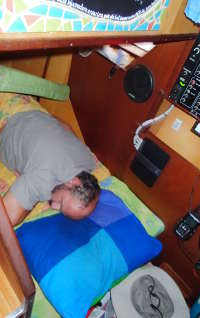
Fortunately, it is not always this way! We have also had some quiet days. But this crossing had relatively many restless days (which was also the opinion of the other sailors). That had to do with the previous period of weird winds, then too little wind to stabilize the boat, and our choice to eventually run ahead to save time.
The wind is right in the direction of the Cape Verde. That seems favorable, but unfortunately it is not so nice. Because the sails are now not more or less longitudinally on the boat, but transversely they do little to dampen the roll of the boat. The rolling becomes so annoying that we decide to change course. We are deliberately going to sail a different course so that the boat becomes much quieter. In the grib files we see that the wind direction will change later in the week and we hope that we can then do the same trick but in the opposite direction in order to arrive comfortably at our destination.
That destination is not yet entirely clear: both Mindelo and Sal are possible options. These islands are far apart and we therefore decide to let the choice depend on what suits sailing best. As we sail further east, Sal is becoming more and more a logical choice.
The full moon that we had all night in the beginning starts to rise later and later, so that now every night starts with complete darkness. Handy, because that way we can get used to this gradually. Also nice by the way, because now we can see the glowing algae again. The boat hits stars out of the water with its bow and the dolphins are also betrayed by the glowing traces they leave behind. Breaking waves explode into luminous foam. It is a fascinating spectacle and before you know it a significant part of the waiting period will have passed by the time the moon rises.
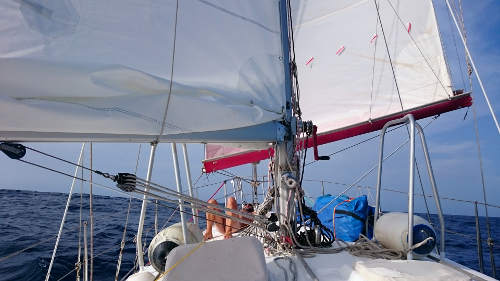
The wind starts to turn but unfortunately does not turn far enough. Despite the fact that we are now far to the east, to reach Mindelo we would get the wind right behind again. Now that the end of the crossing is approaching, it is becoming increasingly clear what our time picture looks like: If we want to visit Sal, then there is a good chance that we will arrive there at night. Arriving at night is not recommended everywhere because buoys are not lit, there may be fishing nets in the water, the maps date from before the GPS era and have never been updated, and treacherous rocks are in places other than the GPS indicates. Speeding up is not going to save enough time to guarantee arrival in daylight, so the only option is to slow down. But at Sal the wind will be more than 20 knots, so sailing slower will also be a bit difficult. Mindelo is half a day longer so that we arrive there without slowing down with daylight and the weather data for Mindelo looks much more favorable. So it means that Mindelo will be the best choice, but unfortunately that means that we have to sail with the wind right behind for no less than two days. Crossing takes too much time and we would arrive at night anyway. Well, we're almost there, so just keep going now.
Suddenly the VHF radio comes to life at night. The range is only about 50 miles, so that means someone is "close". To my surprise, I hear that the sailboat in question is calling on another sailboat with the name "Rock and Roll". This is one of the boats that left with us! I can't hear the Rock and Roll answer, but I can hear the other boat that apparently sails between us. I call the other boat and ask them to give my regards to the Rock and Roll. Both sailboats are on their way to Sal so we will be getting further and further apart now.
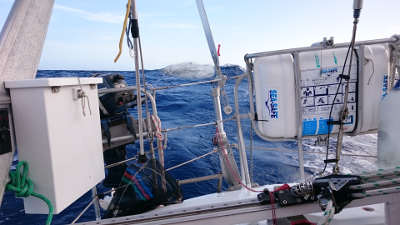
Dolphins, Dolphins, Dolphins! On the penultimate day we are apparently on some route of migrating dolphins. There are hundreds of them and we spend hours in between. We now also have more time to observe what exactly they want with our boat. Because it is clear that they want something with our boat. Every new group that arrives seems to be happy that there is a boat and enthusiastically swims straight towards it. Always to the bow. And when we hang over the bow, there is always a club of dolphins in front of it. They swim with their tails 10 centimeters in front of the bow and hardly move. They use our bow wave to move forward without effort! They surf our bow wave, as it were! The group changes regularly so that several dolphins can rest for a while. Sometimes there is a riot: that is a dolphin that breaks away from a group and swims criss-cross everywhere in between and seems to be challenging others. Such an excursion often ends with a giant jump and somersault over the water, and after a while I get good at predicting which dolphin will jump. In one way or another the dolphins remain extremely fascinating. They leave a void when they suddenly left hours later.
We now regularly calculate the minimum and maximum speed that we have to sail to arrive in Mindelo in daylight. That is between 4.5 and 5.5 knots, so it is relatively easy to achieve. Sometimes the wind comes in for an hour and we only get just 4 knots, but when the wind picks up again we are back at 6 knots speed. We try as best as possible to sail an average of 5 knots so that we keep a margin to both sides. The closer we get, the wider our margins start to widen, until eventually it becomes almost inevitable that we will arrive at exactly noon.
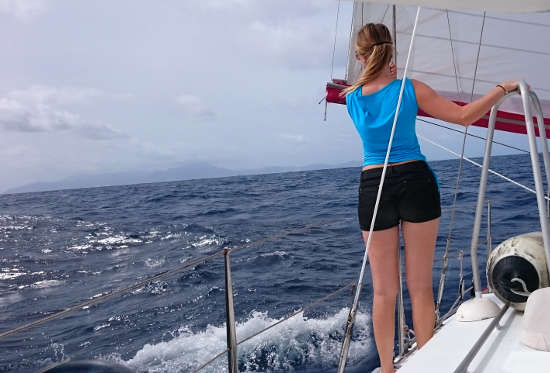
Around sunrise we have already approached Mindelo to within 30 miles and we still see nothing! The ocean air has to rise to blow over the Cape Verde and during that rise, water vapor is created. That makes the Cape Verde ("green cape") moist so that it is livable and indeed turns green. But at the same time, together with the desert dust in the air, it creates a kind of mist that hides the archipelago from view. The only sign that we are approaching land is that I suddenly see pieces of seaweed in the seawater. For example, the explorers of yesteryear must have discovered the islands, or they simply hit them at night ...
Mindelo is located on the side of the Sao Vicente archipelago, in a kind of channel between Sao Vicenten and the neighboring island. The canal has a kind of funnel shape and according to our pilot the wind can increase dramatically. There is also an ocean current that is strongly driven between the islands. We therefore decide to save the sails in time and to do the last part on the engine. The last part is wild with chaotic waves, the "IJsselmeer on steoriden" as our anchor neighbor Mark will remark later. When we finally turn into the bay we are immediately in the lee and we have smooth water. The wind is now blowing through the bay at about 25 knots. Despite the fact that we are concentrating, it does not escape us that it looks "strange" here. No more neat boats, but here and there there is pure scrap anchored. A colorful dinghy sails by with all black men in it. The map shows sunken ships that pose a danger at low tide, but are nevertheless not salvaged or even marked with a warning buoy. Perhaps some more wrecks have been added in the meantime, so we have to be careful.
Now there is some confusion. There is a recreation harbor in the bay as well as an anchorage. We would prefer to anchor because our boat is designed for that. We do not need electricity or water from the quay. Anchoring is free and the harbor here costs 30 Euro per night and that is exclusive use of electricity, water and showers. But in our pilot and navigation computer the anchorage is indicated in the north. But in the north we don't see many opportunities to anchor. And the Dutch that we saw in Mindelo last year were anchored south of the harbor, I had seen that on MarineTraffic ... There are indeed three boats in the south, but whether they are moored or at anchor we cannot see well. We decide to lie down next to the three boats and drop our anchor there. The depth seems good. The operation is a bit exciting because at 25 knots the bow of our boat immediately blows away as soon as we try to lie still, but a little later we are neatly anchored. Now we finally have time to reflect on the fact that we have reached our destination and are now in Africa! We get a bottle of wine from our fridge (we didn't drink alcohol during the whole crossing) and toast to this milestone!
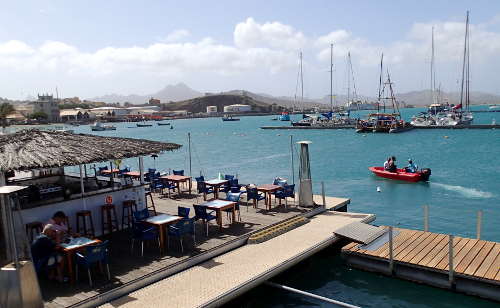
Because it is Sunday, we can wait until Monday with all the formalities. So we can just hupsakee on land. I wonder what is the point of the formalities that await us the next day, but I have never been an expert in bureaucracy. We pump up "Opweg" (our dinghy) and launch it into the water. On the sailboat next to us a black man is watching and waving happily at us. As soon as we start the outboard and sail away, the man gestures us to sail to him, which we of course do. He is from Senegal and has been hired to fix up the boat. He proudly shows all his diplomas immediately. Well, according to our culture a bit crazy, but it should be that way here or there. We don't show our diplomas, we just tell us who we are. He is a nice guy and he shows pictures of Senegal. Why didn't we stop by there? We have indeed considered it, but unfortunately you cannot do everything.
A little later we get back into our boat and now really sail to the shore. The dinghy jetty is at a floating bar, we decide to have a drink there so we can get used to it. Moreover, they have "free wifi" there and once we have the password we can connect to it remotely from the boat with our wifi cannon. Suddenly there is Mark, the Dutchman who left El Hierro exactly when we arrived there. He had indeed not had such good weather during his crossing, but the appointment he wanted to make had been successful. He recommends a restaurant and a little later we have our first meal in Africa.
Our idea to anchor is found interesting; the next day Mark and Carolien leave their harbor and come to lie next to us. Good example to follow: One boat after another leaves the harbor and ends up at anchorage. It will be cozy at the anchorage, but given the nature of the anchoring, the boats cannot be too close together and privacy is guaranteed. In the meantime, more and more boats are trickling in that left El Hierro after us. It is a happy reunion and inspiring to exchange experiences and plans with each other. But now we are getting ahead of ourselves, let's talk about our first encounter with Africa first.